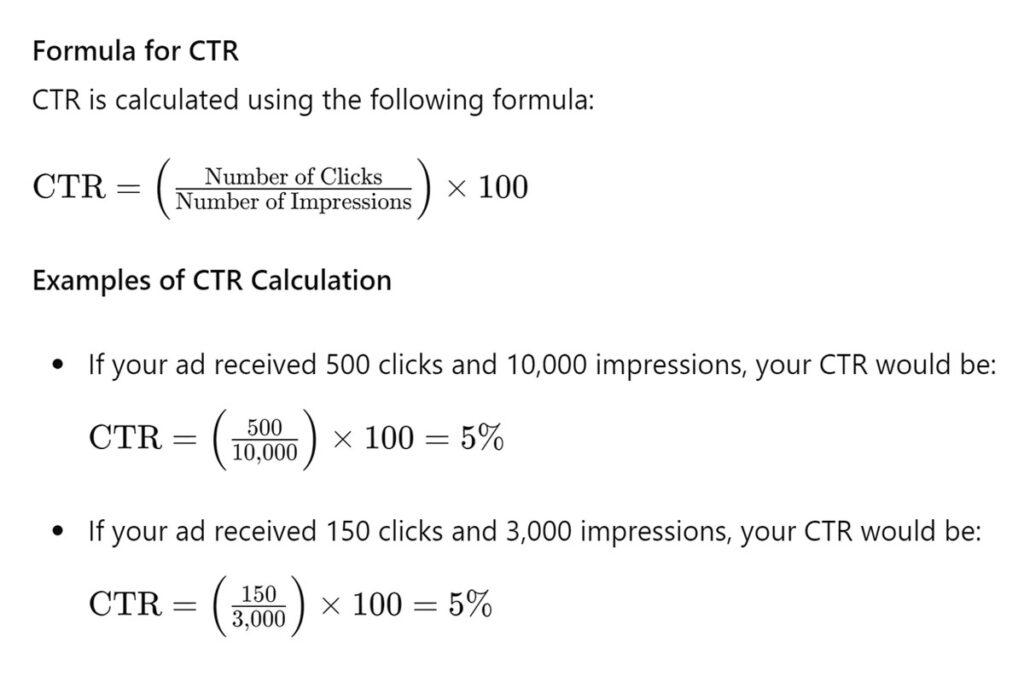
Click-Through Rate (CTR) is a crucial metric in paid search marketing that measures the effectiveness of your ads in capturing the interest of your audience. In this article, we’ll focus on the significance of CTR, how to calculate it, factors that influence it, and strategies to improve it.
Introduction to CTR
Definition and Significance Click-Through Rate (CTR) is the percentage of people who click on your ad after seeing it. It is calculated by dividing the number of clicks by the number of impressions and multiplying by 100. A higher CTR indicates that your ad is engaging and relevant to your audience.
Why CTR Matters in Paid Search Marketing CTR is important because it directly impacts your ad’s performance and Quality Score. A higher CTR can lead to lower cost per click (CPC) and better ad positions, ultimately improving your return on investment (ROI). It also provides valuable insights into how well your ads resonate with your target audience.
How to Calculate CTR
Formula for CTR CTR is calculated using the following formula:

Factors Affecting CTR
Ad Relevance and Quality The relevance and quality of your ad play a significant role in determining CTR. Ads that are closely aligned with the search intent and provide value to the audience are more likely to receive clicks.
Keyword Selection Choosing the right keywords is essential for improving CTR. Relevant and specific keywords that match the search queries of your target audience can increase the chances of your ad being clicked.
Ad Copy and Creativity Compelling ad copy that grabs attention and clearly communicates the benefits of your offer can significantly boost CTR. Using strong call-to-actions (CTAs) and highlighting unique selling points (USPs) can make your ad more attractive.
Ad Position The position of your ad on the search results page affects its visibility and CTR. Ads that appear higher on the page tend to receive more clicks due to increased visibility.
Strategies to Improve CTR
Writing Compelling Ad Copy
- Use attention-grabbing headlines that address the audience’s pain points.
- Include strong CTAs that encourage users to take action.
- Highlight USPs and benefits to differentiate your offer from competitors.
Using Relevant Keywords
- Conduct thorough keyword research to identify relevant and high-performing keywords.
- Use long-tail keywords to target specific search intents and reduce competition.
- Regularly review and update your keyword list to stay aligned with changing trends.
Optimizing Ad Extensions
- Use ad extensions to provide additional information and increase the visibility of your ad.
- Include site link extensions, callout extensions, and structured snippets to enhance your ad’s appeal.
A/B Testing Ad Variations
- Create multiple versions of your ad to test different headlines, ad copy, and CTAs.
- Use A/B testing to identify the most effective ad variations and continuously optimize your campaigns.
Monitoring and Adjusting Bids
- Regularly monitor your ad performance and adjust bids to improve ad position and CTR.
- Use automated bidding strategies to optimize bids based on your campaign goals and performance data.
Information Table on CTR Benchmarks by Industry
| Industry | Average CTR |
|---|---|
| Retail | 2.69% |
| Financial Services | 2.35% |
| Travel & Hospitality | 2.18% |
| Technology | 2.09% |
| Education | 2.13% |
| Healthcare | 1.79% |
| Real Estate | 3.71% |
| Legal | 1.35% |
| Automotive | 2.14% |
| E-commerce | 2.69% |
In the next article, we will explore Cost Per Click (CPC), discussing its importance, how to calculate it, factors influencing it, and ways to optimize CPC for better ROI.

